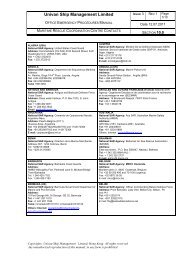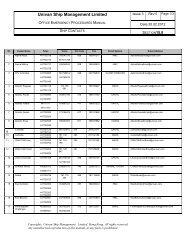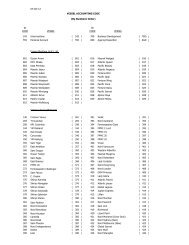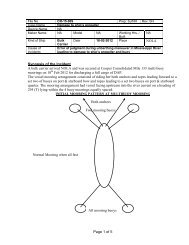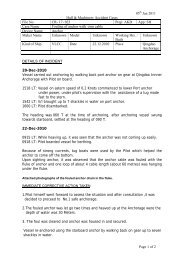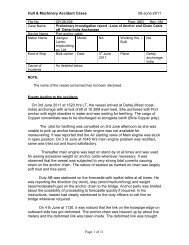Section: 11 CARGO OPERATIONS - Univan
Section: 11 CARGO OPERATIONS - Univan
Section: 11 CARGO OPERATIONS - Univan
Create successful ePaper yourself
Turn your PDF publications into a flip-book with our unique Google optimized e-Paper software.
<strong>Univan</strong> Ship Management Limited Issue 1 REV 0 Page<br />
1/12<br />
FLEET OPERATION MANUAL Date 01.01.2005<br />
<strong>11</strong>.5 Port Operations<br />
<strong>11</strong>.5.1 Arrival procedures<br />
PORT <strong>OPERATIONS</strong><br />
Before arrival port vessel has to follow all the safety procedures as per the company arrival<br />
checklist. Also vessel should be ready in all respect to load and discharge the cargo. The<br />
following are the preparations required before arrival either loading or discharging port.<br />
Copyrights: <strong>Univan</strong> Ship Management Limited, Hong Kong. All rights reserved<br />
Any unauthorized reproduction of this manual, in any form is prohibited<br />
SECTION <strong>11</strong>.5<br />
Check the cargo instructions received are feasible, without any danger to the safety and<br />
stability of ship.<br />
Start Additional generator to cope up with port power consumption, such as winches,<br />
ramp operations, lights and fans for cargo holds.<br />
Ensure the cargo compartment to be used, have their fans and lights on.<br />
Check the cargo compartments are gas free.<br />
Ensure your fire fighting system is in readiness.<br />
Ensure holds are clean, tidy and free of debris.<br />
Ensure any oil spills removed and cleaned up.<br />
All decks, internal ramps and slope ways without any defect which may cause damage to<br />
tires of vehicles.<br />
Ensure all the adjustable deck panels have been adjusted to required heights.<br />
All the cargo compartments which are not required to be worked are completely sealed.<br />
Sufficient quantity of correct type of lashing material is placed in the cargo working area.<br />
Please check the SWL and condition of lashing gear.<br />
Check the condition of D shackles and clover leaves.<br />
Check that no lashing is hanging on the bulkhead and stanchions in such a way that it<br />
may hit and damage the cars.<br />
Ensure the traffic signals and routes are ready using traffic cones.<br />
Ensure safe speed signs (20 Km/Hr) are placed.<br />
Bilges free of water.<br />
Check there is no leaking pipelines in the cargo compartments.<br />
Check there is no condensation on the bulkhead. If there is condensation you may<br />
require ventilating your cargo compartment.<br />
All cargo equipment in good working order. i.e.:<br />
Deck lifter<br />
Pick-up Truck<br />
Non speak battery<br />
Trailer Horse<br />
Your cargo plan should be ready, with stability and stress conditions at various stages of<br />
loading. This should also include any ballasting or deballasting required to be carried out<br />
to adjust the ramp height.<br />
All the cargo not to be worked in this port marked with separation tapes.<br />
All open ends on decks and ramps securely fenced off.<br />
Safety lines to be rigged up for keeping opened deck panels out of bounds.<br />
Check cargo not to be worked at that port is marked with separation tapes.<br />
Upon arrival port the Master, chief officer, Super cargo and in charge of stevedores will discuss<br />
any additional precaution required to be taken for the safety of vessel and the cargo.



